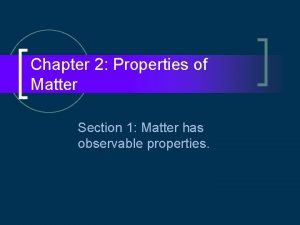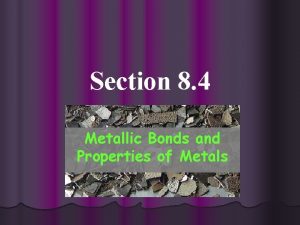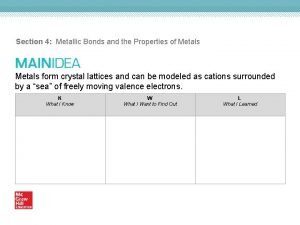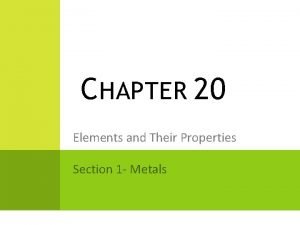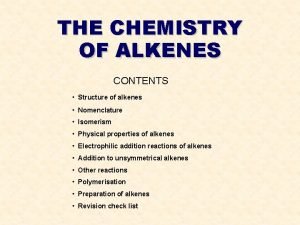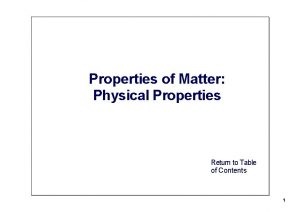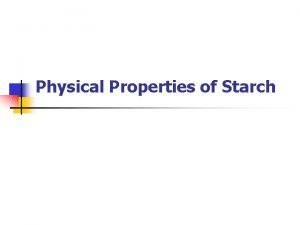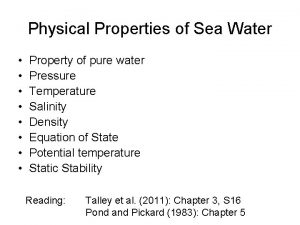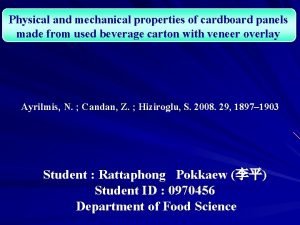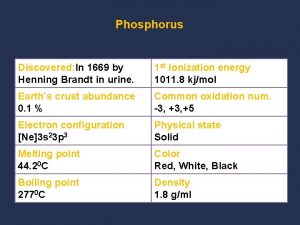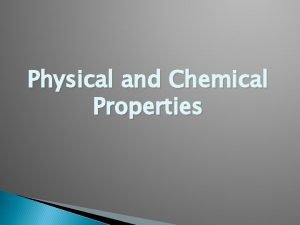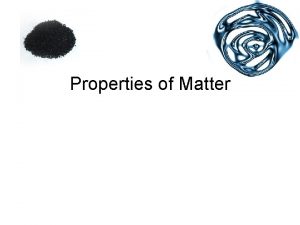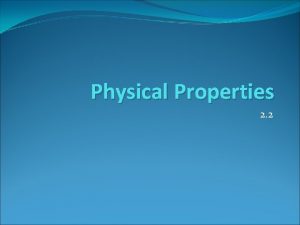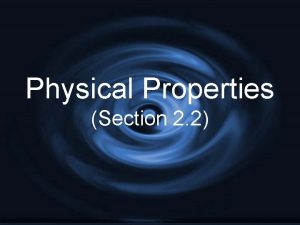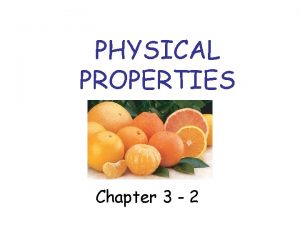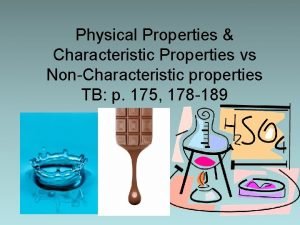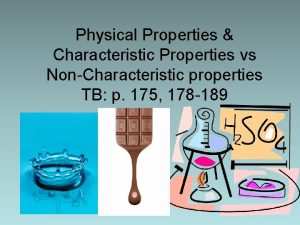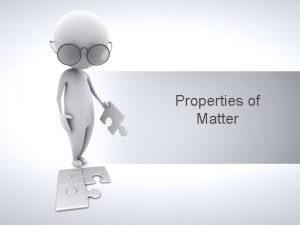Chapter 5 Section 1 Physical Properties 1 Physical






















- Slides: 22

Chapter 5 Section 1

Physical Properties 1 Physical Properties • Scientists used the term physical property to describe a characteristic of matter that you can detect with your senses. • A physical property is any characteristic of matter that can be observed without changing the identity of the material.

Physical Properties 1 Common Physical Properties • You probably are familiar with some physical properties, such as color, shape, smell, and taste. • You might not be as familiar with others, such as, mass, volume, and density.

Physical Properties 1 Common Physical Properties • Mass (m) is the amount of matter in an object. A golf ball has more mass than a table-tennis ball. • Volume (V) is the amount of space that matter takes up. A swimming pool holds a larger volume of water than a paper cup does.

Physical Properties 1 Common Physical Properties • Density (D) is the amount of mass in a given volume. A golf ball is more dense than a table-tennis ball. Density is determined by finding the mass of a sample of matter and dividing this mass by the volume of the sample.

Physical Properties 1 Density • Bowling balls appear to be the same size, shape, and color, but do they all have the same mass? • If you picked up these bowling balls, you would discover that their masses differ. • The densities of the bowling balls are different because their masses are different.

Physical Properties 1 Identifying Unknown Substances • In some cases, density also can be used to identify unknown compounds and elements. • The element silver, for example, has a density of 10. 5 g/cm 3 at 20°C. • You can find the metal's density by dividing the mass of the ring by its volume.

Physical Properties 1 State of Matter • State of matter is another physical property. • The state of matter tells you whether a sample of matter is a solid, liquid, or a gas. • This property depends on the temperature and pressure of the matter. Click here for movie.

Physical Properties 1 Size-Dependant and Size. Independent Properties • Some physical properties change when the size of an object changes. These properties are called size-dependant properties. • For example, a wooden block might have a volume of 30 cm 3. A larger block might have a volume of 60 cm 3. The volume of the block changes when the size of the block changes.

Physical Properties 1 Size-Dependant and Size. Independent Properties • Some physical properties do not change when an object changes size. Density is an example of a size-independent property.

Physical Properties 1 Physical Properties of Acids and Bases • The strength of an acid or base can be determined by finding the p. H of the sample. • The p. H scale has a range of 0 to 14.

Physical Properties 1 Physical Properties of Acids and Bases • Acids have a p. H below 7. • Bases have a p. H above 7.

Physical Properties 1 Physical Properties of Acids and Bases • A sample with a p. H of exactly 7 is neutral— neither acidic nor basic.

Physical Properties 1 Properties of Acids • Some acids, such as concentrated hydrochloric acid, are dangerous. • But some acids are edible. • Carbonated soft drinks contain acids.

Physical Properties 1 Properties of Acids • Every time you eat a citrus fruit such as an orange or a grapefruit, you eat citric and ascorbic (uh SOR bihk) acids.

Physical Properties 1 Properties of Acids • The sharp smell of a freshly sliced lemon comes from the citric acid in the fruit. • Take a big bite out of the fruit and you will immediately notice a sour taste. • If you then rubbed your molars back and forth, your teeth would squeak. • All of these physical properties are common in acids.

Physical Properties 1 Physical Properties of Bases • A familiar example of a base is soap. • Soap has a slippery feel. • You shouldn't taste soap, but if you accidentally did, you'd notice a bitter taste. • A bitter taste and a slippery feel are physical properties of bases.

Section Check 1 Question 1 A tennis ball and a billiard ball may be the same size, but they will definitely not have the same _______. A. density B. parity C. viscosity D. wattage

Section Check 1 Answer The answer is A. The billiard ball is much denser than the tennis ball.

Section Check 1 Question 2 Density is equivalent to mass divided by _______. Answer The answer is volume. The formula for determining density is D = m/V.

Section Check 1 Question 3 An example of a size-independent property is _______. A. density B. mass C. volume D. width

Section Check 1 Answer The answer is A. Other physical properties are shown in this table.
 Physical properties and chemical properties
Physical properties and chemical properties Chapter 10 section 1 meiosis worksheet answer key
Chapter 10 section 1 meiosis worksheet answer key Extensive properties and intensive properties
Extensive properties and intensive properties Buoyancyability
Buoyancyability Chapter 2 properties of matter
Chapter 2 properties of matter Overview elements and their properties answer key
Overview elements and their properties answer key Section 4 metallic bonds and the properties of metals
Section 4 metallic bonds and the properties of metals Section 4 metallic bonds and the properties of metals
Section 4 metallic bonds and the properties of metals Chapter 17 section 3 mixed groups
Chapter 17 section 3 mixed groups Section 4 metallic bonds and the properties of metals
Section 4 metallic bonds and the properties of metals Elements and their properties section 1 metals
Elements and their properties section 1 metals Amino acid optical isomers
Amino acid optical isomers Physical properties of alkenes
Physical properties of alkenes Physical and chemical properties of sulphuric acid
Physical and chemical properties of sulphuric acid 2 hydrogen 1 oxygen
2 hydrogen 1 oxygen Ethan is observing chemical and physical properties
Ethan is observing chemical and physical properties Physical property of starch
Physical property of starch Salinity unit of measurement
Salinity unit of measurement Physical properties of dental materials pdf
Physical properties of dental materials pdf Lesson 2 physical properties answer key
Lesson 2 physical properties answer key Chemical properties of cardboard
Chemical properties of cardboard Changes of matter examples
Changes of matter examples Phosphorus physical state
Phosphorus physical state




